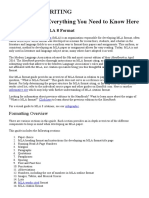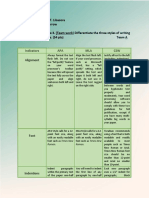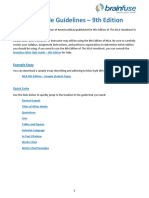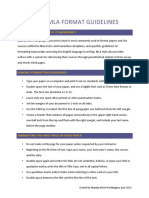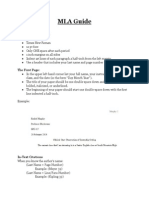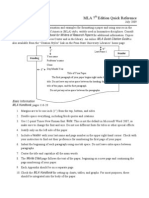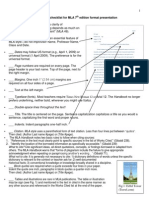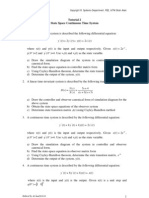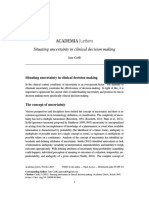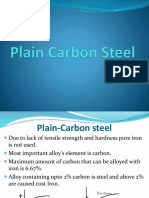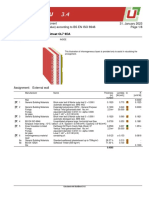MLA General Format
MLA Style specifies guidelines for formatting manuscripts and citing research in writing. MLA
Style also provides writers with a system for referencing their sources through parenthetical
citation in their essays and Works Cited pages.
Writers who properly use MLA also build their credibility by demonstrating accountability to
their source material. Most importantly, the use of MLA style can protect writers from
accusations of plagiarism, which is the purposeful or accidental uncredited use of source material
produced by other writers.
If you are asked to use MLA format, be sure to consult the MLA Handbook (9th edition).
Publishing scholars and graduate students should also consult the MLA Style Manual and Guide
to Scholarly Publishing (3rd edition). The MLA Handbook is available in most writing centers
and reference libraries. It is also widely available in bookstores, libraries, and at the MLA web
site. See the Additional Resources section of this page for a list of helpful books and sites about
using MLA Style.
Paper Format
The preparation of papers and manuscripts in MLA Style is covered in part four of the MLA
Style Manual. Below are some basic guidelines for formatting a paper in MLA Style:
General Guidelines
Type your paper on a computer and print it out on standard, white 8.5 x 11-inch paper.
Double-space the text of your paper and use a legible font (e.g. Times New Roman).
Whatever font you choose, MLA recommends that the regular and italics type styles
contrast enough that they are each distinct from one another. The font size should be 12
pt.
� Leave only one space after periods or other punctuation marks (unless otherwise
prompted by your instructor).
Set the margins of your document to 1 inch on all sides.
Indent the first line of each paragraph one half-inch from the left margin. MLA
recommends that you use the “Tab” key as opposed to pushing the space bar five times.
Create a header that numbers all pages consecutively in the upper right-hand corner, one-
half inch from the top and flush with the right margin. (Note: Your instructor may ask
that you omit the number on your first page. Always follow your instructor's guidelines.)
Use italics throughout your essay to indicate the titles of longer works and, only when
absolutely necessary, provide emphasis.
If you have any endnotes, include them on a separate page before your Works Cited page.
Entitle the section Notes (centered, unformatted).
Formatting the First Page of Your Paper
Do not make a title page for your paper unless specifically requested or the paper is
assigned as a group project. In the case of a group project, list all names of the
contributors, giving each name its own line in the header, followed by the remaining
MLA header requirements as described below. Format the remainder of the page as
requested by the instructor.
In the upper left-hand corner of the first page, list your name, your instructor's name, the
course, and the date. Again, be sure to use double-spaced text.
Double space again and center the title. Do not underline, italicize, or place your title in
quotation marks. Write the title in Title Case (standard capitalization), not in all capital
letters.
Use quotation marks and/or italics when referring to other works in your title, just as you
would in your text. For example: Fear and Loathing in Las Vegas as Morality Play;
Human Weariness in "After Apple Picking"
Double space between the title and the first line of the text.
� Create a header in the upper right-hand corner that includes your last name, followed by a
space with a page number. Number all pages consecutively with Arabic numerals (1, 2, 3,
4, etc.), one-half inch from the top and flush with the right margin. (Note: Your instructor
or other readers may ask that you omit the last name/page number header on your first
page. Always follow instructor guidelines.)
ection Headings
Writers sometimes use section headings to improve a document’s
readability. These sections may include individual chapters or other
named parts of a book or essay.
Essays
MLA recommends that when dividing an essay into sections you number
those sections with an Arabic number and a period followed by a space
and the section name.
1. Early Writings
2. The London Years
3. Traveling the Continent
4. Final Years
Books
MLA does not have a prescribed system of headings for books (for more
information on headings, please see page 146 in the MLA Style Manual
and Guide to Scholarly Publishing, 3rd edition). If you are only using one
level of headings, meaning that all of the sections are distinct and
parallel and have no additional sections that fit within them, MLA
recommends that these sections resemble one another grammatically.
For instance, if your headings are typically short phrases, make all of the
�headings short phrases (and not, for example, full sentences).
Otherwise, the formatting is up to you. It should, however, be consistent
throughout the document.
If you employ multiple levels of headings (some of your sections have
sections within sections), you may want to provide a key of your chosen
level headings and their formatting to your instructor or editor.










